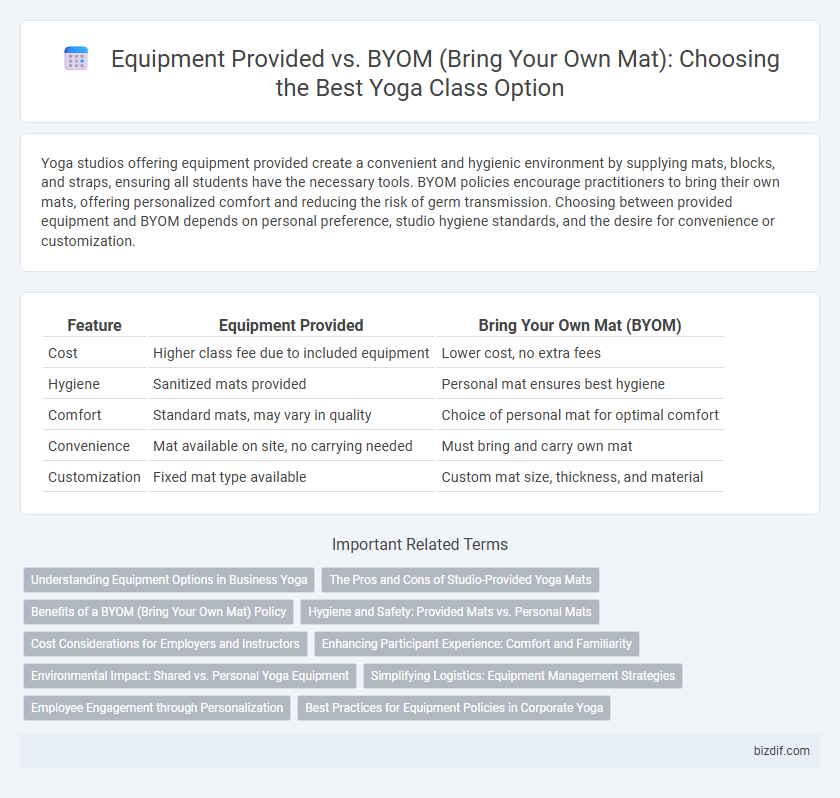Yoga studios offering equipment provided create a convenient and hygienic environment by supplying mats, blocks, and straps, ensuring all students have the necessary tools. BYOM policies encourage practitioners to bring their own mats, offering personalized comfort and reducing the risk of germ transmission. Choosing between provided equipment and BYOM depends on personal preference, studio hygiene standards, and the desire for convenience or customization.
Table of Comparison
| Feature | Equipment Provided | Bring Your Own Mat (BYOM) |
|---|---|---|
| Cost | Higher class fee due to included equipment | Lower cost, no extra fees |
| Hygiene | Sanitized mats provided | Personal mat ensures best hygiene |
| Comfort | Standard mats, may vary in quality | Choice of personal mat for optimal comfort |
| Convenience | Mat available on site, no carrying needed | Must bring and carry own mat |
| Customization | Fixed mat type available | Custom mat size, thickness, and material |
Understanding Equipment Options in Business Yoga
Business yoga programs often offer both equipment-provided sessions and BYOM (Bring Your Own Mat) options to accommodate diverse participant preferences and workplace environments. Providing mats, blocks, and straps ensures consistency in class setup and reduces barriers to entry for employees new to yoga. BYOM policies encourage personal comfort and hygiene while fostering sustainability by minimizing shared equipment use.
The Pros and Cons of Studio-Provided Yoga Mats
Studio-provided yoga mats offer convenience and hygiene control, ensuring all practitioners have clean, high-quality gear without the need to transport personal equipment. However, these mats may not cater to individual preferences in thickness, texture, or material, potentially affecting comfort and performance. Bringing your own mat allows for personalized selection but requires regular cleaning and carrying, which could be cumbersome for some yogis.
Benefits of a BYOM (Bring Your Own Mat) Policy
A BYOM (Bring Your Own Mat) policy in yoga classes promotes personal hygiene by allowing practitioners to use mats tailored to their comfort and cleanliness preferences. Using a personal mat reduces the risk of germs and allergens commonly found on shared equipment, enhancing overall class safety. This practice encourages sustainability by minimizing the need for rental mats, supporting eco-friendly choices and long-term cost savings for participants.
Hygiene and Safety: Provided Mats vs. Personal Mats
Using provided yoga mats ensures standardized hygiene practices through regular sanitization, reducing the risk of surface contamination and potential infections in group classes. Personal mats maintain individual hygiene standards by minimizing exposure to germs from other users but require proper cleaning routines to prevent bacteria buildup. Prioritizing safety, studios often recommend personal mats or enforce strict cleaning protocols on provided mats to balance convenience with health concerns.
Cost Considerations for Employers and Instructors
Providing yoga mats and equipment in classes involves upfront costs for employers and instructors, impacting overall budget allocations for wellness programs. Encouraging participants to bring their own mats (BYOM) reduces expenses but may limit control over hygiene standards and consistency in class experience. Balancing cost efficiency with quality assurance is critical for sustainable yoga instruction operations and participant satisfaction.
Enhancing Participant Experience: Comfort and Familiarity
Providing yoga mats and props ensures consistent quality and hygiene, enhancing participant comfort and confidence during practice. Allowing BYOM (Bring Your Own Mat) offers familiarity and personalized cushioning, which can improve alignment and focus for seasoned practitioners. Balancing supplied equipment with BYOM options caters to diverse preferences, optimizing the overall experience and engagement in yoga sessions.
Environmental Impact: Shared vs. Personal Yoga Equipment
Using shared yoga equipment in studios significantly reduces environmental waste by minimizing the production and disposal of individual mats and props. Personal mats, often made from non-biodegradable materials, contribute to landfill overflow and pollution when frequently replaced. Opting for communal, eco-friendly yoga gear supports sustainability by promoting resource conservation and lowering carbon footprints within the yoga community.
Simplifying Logistics: Equipment Management Strategies
Providing yoga equipment streamlines class preparation by eliminating the need for participants to bring their own mats, ensuring uniformity and reducing setup time. BYOM policies empower individuals to use personal, familiar mats, enhancing comfort but requiring careful coordination for storage and cleanliness. Efficient equipment management balances convenience and hygiene while minimizing logistical challenges for instructors and studio staff.
Employee Engagement through Personalization
Providing yoga mats and accessories enhances employee engagement by reducing barriers to participation and promoting inclusivity. Allowing employees to bring their own mats encourages personalization, fostering a sense of ownership and comfort during practice. Balancing provided equipment with BYOM options supports diverse preferences and increases overall satisfaction in workplace wellness programs.
Best Practices for Equipment Policies in Corporate Yoga
Establishing clear equipment policies in corporate yoga programs enhances participant comfort and engagement by offering high-quality mats while encouraging BYOM (Bring Your Own Mat) for personal hygiene preferences. Providing sanitized, durable mats reduces health risks and logistical challenges, whereas promoting BYOM empowers employees to use familiar gear, fostering inclusivity and ownership. Balancing supplied equipment with BYOM options aligns with best practices, ensuring safety standards and accommodating diverse needs within corporate wellness initiatives.
Equipment Provided vs BYOM (Bring Your Own Mat) Infographic

 bizdif.com
bizdif.com